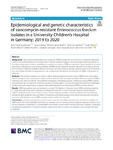2022-03-12Zeitschriftenartikel
Epidemiological and genetic characteristics of vancomycin-resistant Enterococcus faecium isolates in a University Children's Hospital in Germany: 2019 to 2020
Trautmannsberger, Ilona
Kolberg, Laura
Meyer‑Buehn, Melanie
Huebner, Johannes
Werner, Guido
Weber, Robert
Heselich, Valerie
Schroepf, Sebastian
Muench, Hans‑Georg
von Both, Ulrich
Background:
Vancomycin-resistant Enterococcus faecium (VREfm) strains are one of the most important pathogens causing nosocomial infections in Germany. Due to limited treatment options and an increased risk for acquisition in immunocompromised children, surveillance to monitor occurrence of VREfm in paediatric clinical facilities is of critical importance. Following an unusual accumulation of VREfm positive patients between April 2019 and August 2020 at Dr. von Hauner Children’s Hospital in Munich, Germany, our study aimed to identify dynamics and routes of transmission, and analyse the affected population in view of previously described host risk factors for VREfm colonisation or infection.
Methods:
The hospital database was used to collect epidemiological and clinical data of VREfm cases. Descriptive statistical analyses were conducted to outline patient characteristics and depict possible differences between VREfm-colonised and -infected children. An outbreak investigation determining genetic relatedness among VREfm isolates was performed by core genome multilocus sequence typing (cgMLST). To examine potential transmission pathways, results of genome analysis were compared with epidemiological and clinical data of VREfm positive patients.
Results:
VREfm acquisition was documented in a total of 33 children (< 18 years). Seven VREfm-colonised patients (21.2%), especially those with a haemato-oncological disease (4/7; p = 0.011), showed signs of clinical infection. cgMLST analysis revealed seven distinct clusters, demonstrating a possible connection within each clonal lineage. Additional eight singletons were identified. Comparison with epidemiological and clinical data provided strong evidence for a link between several VREfm positive patients within the hospital.
Conclusions:
A nosocomial spread—at least in part—was the most likely reason for the unusual accumulation of VREfm cases. The study highlights that there is a constant need to increase efforts in hygiene measures, infection control and antibiotic stewardship to combat VREfm transmission events within German paediatric hospitals. Continuous monitoring of adherence to respective policies might reduce the occurrence of clustered cases and prevent future outbreaks.
Files in this item

